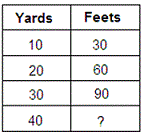Solved Examples and Worksheet for Arithmetic Patterns Involving Addition and Multiplication
A. 3 and 8
B. 4 and 10
C. 1 and 7
D. 1 and 6
Step: 1
The rule for the pattern is to count up each term by 5 to obtain the
succeeding terms in the sequence.
Step: 2
So, the first two terms in the series are 3 and 8.
Correct Answer is : 3 and 8
1, 5, 9, 13, . . .
A. each number comes from doubling the previous number
B. each number comes from halving the previous number and then adding one
C. each number comes from doubling the previous number and then subtracting one
D. each number comes by adding 4 to the previous number
Step: 1
Each term in the sequence is 4 more than the previous term.
Step: 2
So, the rule is 'each number comes by adding 4 to the previous number'.
Correct Answer is : each number comes by adding 4 to the previous number
A. add 7 to the first term, 8 to the second term, 5 to the third term
B. add 5 repeatedly to each term and multiply by 10
C. add 5 to the first term, 7 to the second term, 9 to the third term and so on
D. multiply each term by 5
Step: 1
In the pattern, 5 is added to the first term, 7 is added to the second term, 9 is added to the third term and so on to obtain their succeeding terms in the sequence.
Step: 2
So, the rule for the pattern is to add 5 to the first term, 7 to the second term, 9 to the third term and so on, repeatedly to obtain the succeeding terms in the sequence.
Correct Answer is : add 5 to the first term, 7 to the second term, 9 to the third term and so on
A. 165 and 210
B. 155 and 210
C. 175 and 210
D. 165 and 220
Step: 1
The rule for the pattern is to count up by 45 for each succeeding term.
Step: 2
So, the missing numbers in the sequence are 165 and 210.
Correct Answer is : 165 and 210
10, 20, 30, 40, 50, . . .
A. Subtract 10 from each number to get the next number.
B. Add 10 to each number to get the next number.
C. Multiply each number by 2 to get the next number.
D. Add 2 to each number to get the next number.
Step: 1
Each term in the in sequence is 10 more than previous term.
Step: 2
So, the rule is 'Add 10 to each number to get the next number'.
Correct Answer is : Add 10 to each number to get the next number.
48, 51, 54, __, __
A. 51 and 54
B. 57 and 60
C. 57 and 50
D. 56 and 59
Step: 1
In the pattern, each number is obtained by adding 3 to the previous number.
Step: 2
So, 54 + 3 = 57,
57 + 3 = 60.
57 + 3 = 60.
Step: 3
So, the numbers 57 and 60 complete the number pattern.
Correct Answer is : 57 and 60
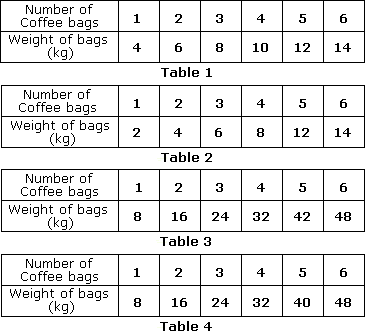
A. Table 4
B. Table 2
C. Table 1
D. Table 3
Step: 1
Each coffee bag weighs 8 kg.
Step: 2
As the number of coffee bags increases by 1, the total weight increases by 8.
Step: 3
So, Table 4 gives the total weight of 6 such bags.
Correct Answer is : Table 4
Step: 1
The sequence is obtained when 8 is added to the preceding term.
Step: 2
The next term of the pattern is 5 th term.
Step: 3
5 th term = fourth term + 8 = 24 + 8 = 32
Step: 4
The next term of the pattern is 32.
Correct Answer is : 32
| Feet | Inches |
| 10 | 120 |
| 20 | 240 |
| 30 | 360 |
| 40 | ? |
A. 460
B. 490
C. 480
D. 470
Step: 1
We have, 1feet = 12 inches.
Step: 2
Make a table to calculate the number of inches for 10, 20, 30 and 40 as the values for the number of feet.
Step: 3
We will get the table,
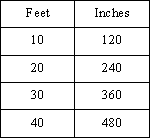

Step: 4
So, the missing number is 480.
Correct Answer is : 480
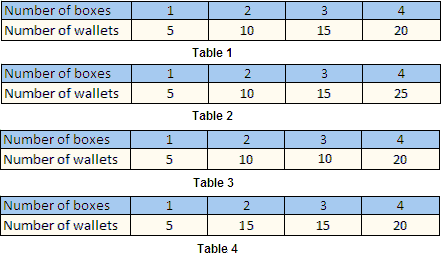
A. Table 3
B. Table 1
C. Table 4
D. Table 2
Step: 1
Given that a box has 5 wallets. By multiplying the number of boxes × 5, we get 10 wallets for 2 boxes.
Step: 2
Similarly, for 3 boxes we get 15 wallets and so on.
Step: 3
Therefore, Table 1 gives the correct answer.
Correct Answer is : Table 1
Step: 1
We have, 1yard = 3 foot.
Step: 2
Make a table to calculate the number of foots for 10, 20, 30, and 40 as the values for the number of yards.
Step: 3
We will get the table,
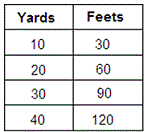

Step: 4
So, the missing value is 120.
Correct Answer is : 120
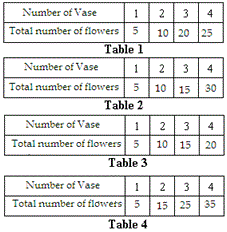
A. Table 2
B. Table 3
C. Table 4
D. Table 1
Step: 1
A vase has 5 flowers. By multiplying the number of vase × 5, we get 10 flowers for 2 vase.
[2 × 5 = 10.]
Step: 2
Similarly, for 3 and 4 vases we get 15 and 20 flowers respectively.
[3 × 5 = 15.]
[4 × 5 = 20.]
[4 × 5 = 20.]
Step: 3
Therefore, Table 3 gives the correct answer.
Correct Answer is : Table 3
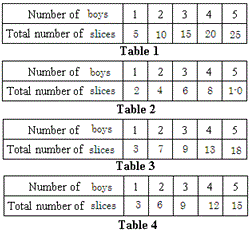
A. Table 2
B. Table 1
C. Table 4
D. Table 3
Step: 1
Each boy eats 3 slices of bread. By multiplying the number of boys × 3, we get 6 slices for 2 boys.
[2 × 3 = 6.]
Step: 2
Similarly, for 5 boys we get 15 slices .
[3 × 5 = 15.]
Step: 3
Therefore, Table 4 gives the correct answer.
Correct Answer is : Table 4
- Multiplication Arrays-Gr 3-Solved Examples
- Multiplying 1-Digit Numbers by 1 Digit-Gr 3-Solved Examples
- Multiplying 2-Digit Numbers by 1-Digit Number-Gr 3-Solved Examples
- Number Sentences involving Multiplication-Gr 3-Solved Examples
- Dividing 2-Digit Numbers by 1-Digit Numbers without Remainders-Gr 3-Solved Examples
- Model Division using Equal Groups-Gr 3-Solved Examples
- Number Sentences involving Division-Gr 3-Solved Examples
- Finding Missing Number using Multiplication or Division-Gr 3-Solved Examples
- Multiplication and Division Facts-Gr 3-Solved Examples
- Exploring Commutative Property of Multiplication-Gr 3-Solved Examples
- Exploring Associative Property of Multiplication-Gr 3-Solved Examples
- Distributive Property of Multiplication over Addition-Gr 3-Solved Examples
- Solving Two-step Word Problems-Gr 3-Solved Examples
- Application of Estimating Whole Numbers-Gr 3-Solved Examples
Related Worksheet
- Number Patterns
- Pattern
